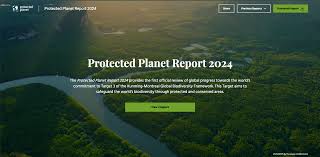Protected Planet Report 2024

- 08 Nov 2024
In News:
The Protected Planet Report 2024, released by UNEP-WCMC and IUCN, evaluates global progress toward achieving Target 3 of the Kunming-Montreal Global Biodiversity Framework (KM-GBF). This target aims to conserve 30% of Earth's terrestrial, inland water, coastal, and marine areas by 2030.
Key Highlights of the Report
- Current Global Coverage
- Land and Inland Waters: 17.6% protected.
- Oceans and Coastal Areas: 8.4% protected.
- Progress since 2020: Minimal increase (<0.5% for both realms), equivalent to an area twice the size of Colombia.
- Remaining Challenges to Achieve Target 3 by 2030
- Land: An additional 12.4% of land area must be protected (equivalent to Brazil + Australia).
- Ocean: 21.6% more marine areas must be safeguarded (larger than the Indian Ocean).
- Key Gaps:
- Only 8.5% of protected areas on land are well-connected.
- Only one-fifth of the areas critical for biodiversity are fully protected.
- Biodiversity representation remains uneven, with some ecological regions having no protection at all.
- Governance and Effectiveness Issues
- Less than 5% of protected land and 1.3% of marine areas have management effectiveness assessments.
- Only 0.2% of protected land and 0.01% of marine areas have undergone equitable governance assessments.
- Indigenous governance covers less than 4% of protected areas despite Indigenous and traditional territories covering 13.6% of the terrestrial areas.
- Ocean Conservation Progress: Most progress is in national waters; however, areas beyond national jurisdiction (the high seas) remain underrepresented (<11% coverage).
- Data Deficiency: Insufficient data to measure biodiversity outcomes, equity, and governance in protected areas.
Importance of Target 3
- Biodiversity Benefits: Protected areas play a critical role in halting and reversing biodiversity loss.
- Ecosystem Services: These areas contribute to clean air, water, climate regulation, and food security.
- Cultural and Economic Significance: They uphold the rights of Indigenous Peoples and local communities, ensuring equitable governance and sustainable resource use.
Key Recommendations
- Accelerate Conservation Efforts:
- Expand protected and conserved areas with a focus on biodiversity hotspots.
- Ensure areas are ecologically connected and effectively managed.
- Strengthen Indigenous and Local Contributions:
- Recognize and support the stewardship of Indigenous Peoples and local communities.
- Ensure their voices and knowledge systems are integrated into conservation planning.
- Improve Governance and Equity:
- Address gaps in equitable governance and include rights-based approaches.
- Global Cooperation:
- Increase international financing to developing nations for biodiversity conservation.
- Foster cross-border partnerships and support data-sharing initiatives.
- Enhance Data Availability:
- Collect and disseminate data on the effectiveness of protected areas and their biodiversity outcomes.
India’s Role and Strategy
- Commitment to KM-GBF: India updated its National Biodiversity Strategy and Action Plan (NBSAP) to align with the KM-GBF goals, aiming to protect 30% of natural areas by 2030.
- Focus on Restoration: Prioritizes the restoration of forests, rivers, and other ecosystems to maintain essential resources like clean air and water.
- Indigenous Participation: India emphasizes integrating Indigenous territories into its conservation framework.
